
Technical Memorandum
DATE: October 4, 2018
TO: Boston Region Metropolitan Planning Organization
FROM: Bill Kuttner
RE: Intermodal Warehouses in Massachusetts
The Federal Highway Administration (FHWA) makes resources available to states and Metropolitan Planning Organizations (MPO) to support freight planning, including nonhighway freight modes. FHWA makes data available through its Freight Analysis Framework (FAF) set of online databases. The latest version, FAF4, includes data on intermodal terminals, and this study is intended to corroborate, update, and incorporate these data into the freight planning and modeling efforts of the Boston Region MPO and the state.
Less than five percent of goods carried by for-hire freight carriers in Massachusetts travels by rail.1 A large amount of freight is also carried by private truck fleets where a firm is carrying its own goods. There is no federal reporting requirement for this type of freight traffic; it is impossible to calculate a precise rail freight mode share, but it will be appreciably lower than the five percent calculation. When the many trucks involved in local pickup and delivery are also considered, it is understandable why MPO analyses of freight transportation have focused primarily on the motor carrier industry.
The nontruck freight modes serving the MPO region are not ignored, however. Because most freight that travels by air, rail, or ocean shipping must use a truck to connect with the shipment origin or final destination, the transportation markets of these modes can be analyzed by studying the truck distribution patterns generated by these modes. A survey of trucks entering and leaving the Conley Marine Container Terminal in Boston revealed the geographical extent of import and export services through the port of Boston.2 The regional distribution of shipping containers and semi-trailers arriving by rail at Worcester or the Devens industrial area (former Fort Devens) might be studied similarly.
The focus of this study, however, is a class of intermodal terminals that does not figure prominently in public policy discussions: commercial intermodal warehouses that offer logistic services. These facilities offer truck loading docks, an on-site rail siding, and a number of value-added logistic services. Because much of their revenue is derived from storage and logistic services, these facilities do not necessarily generate the large volumes of truck movements associated with the large intermodal terminals that merely transfer cargoes from one mode to another.
The intermodal warehouses and related facilities discussed in this memorandum are located throughout Massachusetts, but are of interest to the Boston Region MPO for three reasons:
This memorandum continues with a discussion of the logistic services offered by intermodal commercial warehouses. A following section will consider some of the planning implications of these facilities. There is a brief discussion of how trucks serving these locations might be considered in the model development process. Some land-use implications of these and related facilities are also discussed.
The next section briefly describes the types of transportation equipment in common use at intermodal warehouses, and then presents the 10 intermodal warehouses that were identified as part of this study. Each facility is shown in an aerial photo that highlights relevant industrial activity in its environs. A brief summary with conclusions completes the memorandum.
Any business or government activity that involves the movement of a significant amount of goods needs to consider the costs and reliability of these physical movements. The costs and reliability of the acquisition of goods by key suppliers or the movement of products from distributors to end users may also merit consideration. Taken altogether, these activities and concerns are sometimes referred to as the supply chain.
Many of the largest industrial and retail enterprises have been able to vertically integrate key parts of their supply chain. These firms might own or operate their own warehouses or semi-trailers, and haul the semi-trailers with their own drivers and tractors or arrange for owner-operators of tractors to provide this service. Even the largest firms are likely to use a combination of in-house and for-hire logistic services, and smaller firms generally look to acquire transportation services unless the benefits of vertical integration are compelling.
The supply chain can be very complex, and there are always situations where total logistic costs might be reduced or reliability improved. Conversely, supply chain miscalculations can result in myriad unanticipated problems. Transportation within a country must be coordinated with any related import or export movements, and the available options and costs are changing constantly for both domestic and foreign freight movements.
Even as firms acknowledge the importance of logistics, they must focus on their primary business and stay competitive in their markets. The problem of optimizing all or part of the supply chain is sometimes contracted out to specialized firms known as third-party logistic firms, or 3PLs for short. Working offsite, some of these firms apply their knowledge of transportation services and contractual relationships with carriers. Other 3PL operations are value-added services of a carrier or warehouse operator.
One of the most versatile tools in supply chain management is the modern commercial warehouse. In the vernacular, warehouse still evokes an image of storage only. The contents of today’s modern warehouse are usually within a day’s drive of the prospective final customer. The services that the warehouse operator can keep out of both the shipper’s facility and the final customer’s facility include:
Some of these services are not merely replacing efforts that might be done by the shipper. Finished goods inventories can be kept lower if steps such as packaging and labeling can be postponed until customer orders are received.
Commercial warehouses also offer services associated with the physical movement of goods that they often can perform more efficiently than the client. These warehouses either own, or have arranged to be served by, a fleet of trucks. These trucks can vary in size and offer features such as refrigeration or lift-gates for deliveries at locations without loading docks such as on-street deliveries. If there are opportunities to consolidate shipments, a lower rate might be offered. Conversely, time-sensitive deliveries can be expedited if necessary at extra cost.
The warehouses highlighted in this study also have on-site rail sidings, which allow receipt of goods in boxcars. The use of railroad boxcars has been in long-term decline as use of trucks and intermodal containers have grown, but accommodating this class of equipment is part of offering complete logistic services. It is very likely that either the shipper or the receiver may not have a rail siding, so rail service at the warehouse makes possible the use of rail for at least one leg of the journey. In practice, shipment by rail boxcar is likely to be selected only for lengthy movements of large consignments. Intermodal shipping containers may be traveling by ocean or rail, but at the warehouse they are handled like conventional semi-trailers.
Containers used in foreign trade have administrative requirements in addition to the logistics of managing the physical container and its contents. Some commercial warehouses have a portion of their facilities designated as a customs bonded warehouse or a foreign trade zone. Many goods can enter the United States and be held at these locations without clearing customs. Customs clearance and payment of tariffs or duties is required only when the goods leave this federally approved location.
Modeling freight travel demand is different than modeling passenger travel demand in important respects. The diversity of commodities and availability of data are only two of the more prominent differences. A convenient starting point for bringing freight into the MPO travel demand modeling process is the Quick Response Freight Manual published by FHWA.3
The Quick Response Manual describes two broad approaches to modeling freight. In one approach the flows of commodities are estimated, and these movements are converted into vehicle movements by the freight modes being modeled. If the geographical area being modeled is not large, it is more practical to only represent freight as trucks, vans, and heavy vehicles using the road system. The Boston Region MPO uses the second approach, treating freight and heavy vehicles as a component of traffic both in the 164-municipality regional travel demand model and the more extensive statewide model.
The warehouses discussed here present challenges in both these approaches. Commodity-based modeling will always have difficulty representing warehouses because commercial warehouses usually handle many different commodities.
When freight is represented as simply the flow of trucks, the first problem is to estimate the number of truck trips that will be generated at a specific location. Truck trip generation rates are usually based on the numbers of employees by industry type. An office building is estimated to require deliveries of office supplies at a rate based on the number of workers. A different set of truck trip generation rates would be applied to the number of workers at a factory.
The Quick Response Manual provides some published truck trip generation rates based upon employment, but considers intermodal terminals to be special generators for which employee-based truck trip generation would not be expected to apply. It recommends that these locations be surveyed and that truck trip rates unique to the facility be estimated. The MPO has already studied the Conley Terminal in Boston, and studying the major rail-truck intermodal terminals outside the MPO region in Worcester and Devens might be appropriate at some point.
The intermodal warehouses identified in this study would also qualify as special generators by the criteria used in the Quick Response Manual. Analysis of these locations would be more like a case study, relating truck trips generated to a volume of business that would include a number of value-added services and unloading boxcars, each one of which can carry as much as three trucks.
MPO members and stakeholders have long expressed concern about the large and increasing volume of regional truck traffic. Rail freight and trucks are often considered substitutes, and investments in freight rail are recommended to slow the growth rate of truck traffic. That might be the case in some freight markets, but this study illustrates how these two modes work together to increase the efficiency of freight-intensive sectors of the regional economy. As the economy expands, freight-intensive industries can be expected to also expand to some degree, and growth should be expected in both freight movements and logistic services.
Practical locations for industrial activity have always required a source of power, available labor, and a means of moving materials and goods. The long-distance transmission of electrical power, the personal mobility provided by automobiles, and a motor carrier industry using a nationwide road network have provided industrial planners with many options for siting industrial activities. This expansion of geographic options has also resulted in intense competition to serve markets efficiently, and freight traveling by rail, water, or air can supplement the geographical reach of trucks and provide critical cost or timeliness advantages in many freight markets.
Before the development of diesel trucks and semi-trailers early in the last century, industrial logistics depended almost exclusively on railroads, supplemented at some locations by barges or ships. Rail service today is concentrated on a number of high-capacity corridors connecting high-volume shippers, customers, and intermodal terminals. The number and extent of branch rail lines have contracted, but many medium-sized rail customers still use carload (nonintermodal) rail service on their own siding off a main line or one of the remaining branch lines. The intermodal terminals studied here are examples of this.
These two trends, the dispersion of industrial activity and the concentration of freight rail into high-volume corridors, have fundamentally changed the nature of urban rail systems. Today’s commuter rail lines were once lined with carload freight customers. These urban trackside industrial areas have evolved, along with the cities they are part of. Much industry remains, though now it is mostly served by trucks. Many facilities are now obsolete for industrial purposes but find new life for office, mixed-use, or even residential activity. If they cannot be adapted, they can be replaced with new construction. Upgrading the transit capabilities in these corridors makes them even more attractive for nonindustrial uses.
This land-use evolution is happening today in suburban industrial areas. The growth of post-World War II suburbs was facilitated by construction of a new regional express highway system. Less well appreciated is that fact that industrial activity also expanded into the new suburbs. These facilities were modern at the time, and many were served by rail sidings. As industrial activity gradually expands in scale to remain competitive, freight-intensive industries are investing in newer, larger facilities outside the fully developed suburbs, and many of the 1950s era industrial sites are being adapted for less freight-intensive purposes.
The intermodal warehouses presented in this memorandum cannot relocate their operations as readily as businesses that rely solely on trucks. Only a fraction of available industrial sites have existing or potential rail access, and there may be expenses for adding or improving an access track. Agreements would also need to be negotiated with both the rail service provider and the owner of the railroad line, who are not always the same.
Just because there are challenges to relocating a profitable intermodal warehouse doesn’t mean that it will not happen. It would be tempting to think of an intermodal warehouse as a kind of anchor preserving the character of an industrial area that might otherwise be transitioning into offices and martial arts studios. Rather, this study suggests that when industrial areas are considered from a planning perspective that the logistic needs and practices of the various businesses be understood individually.
Logistic planners face an array of complicated issues and options as they design efficient supply chains. However, they have at their service extensive fleets of interchangeable equipment and industry practices that realize logistic efficiencies through economies of scale. Some of these are illustrated in this section, mostly using photos recently taken at Devens.
Figure 1 shows the truck-loading apron of a newly expanded warehouse. Many of the more than 100 loading bays are occupied by a variety of trailer-type equipment. A tractor is attached to a load in the foreground, and in the background tractors are leaving and arriving with loads. The entire warehouse structure is 1,670 feet in length.
Figure 1
Newly Expanded Warehouse with More Than 100 Truck Loading Bays

Source: Central Transportation Planning Staff.
The side of the warehouse opposite the truck-loading apron is shown in Figure 2. The boxcar on the far right is higher than the other three cars, and is a high-cube configuration. At the end of the warehouse extension is a two-track indoor siding, shown in Figure 3. A smaller outdoor truck-loading bay with rubber bellows is partly visible to the left, suggesting the size difference between a large boxcar and modern trailer-type equipment. A factor of three is often cited as an approximate boxcar-truck capacity ratio.
Figure 2
New Rail Siding Adjacent Expanded Warehouse
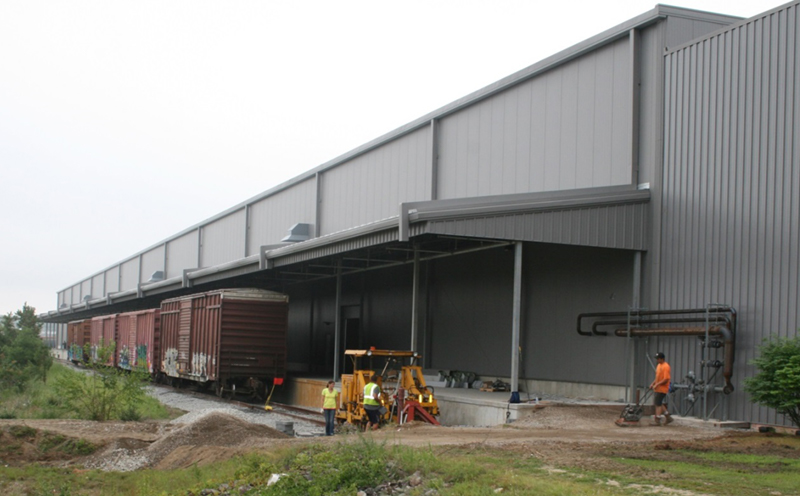
Source: Central Transportation Planning Staff.
Figure 3
Two-Track Siding Inside Expanded Warehouse
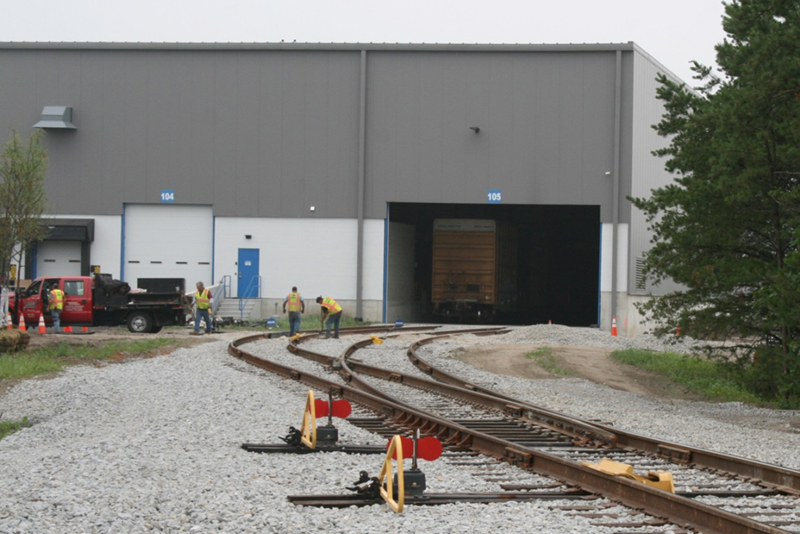
Source: Central Transportation Planning Staff.
Only one track is adjacent the warehouse floor, but boxcars can be positioned, or “spotted,” on the second track so that their doors are directly opposite the doors of the boxcars on the first track. Bridge plates are used to connect the first boxcar with the warehouse floor, and the adjacent boxcars to each other, allowing forklifts to unload two boxcars as part of the same operation.
Figure 4 shows a mix of trailer-type equipment docked at six adjacent loading bays. The first three semi-trailers are standard 53-foot dry vans, the largest size trailer that can operate on highways without a special permit. One of the three dry vans is owned by the Price Chopper supermarket chain and also serves as a rolling billboard.
The red vehicle in the center of the group is a 40-foot ocean shipping container. It is attached to a chassis with a set of rubber tires that allow it to be connected to a tractor and operated in the same manner as a standard semi-trailer. The dimensions of these containers were standardized in the 1950s, and today they are smaller than all but the smallest dry vans. Also, they are designed with high-strength corner posts that allow tall stacks of containers on today’s large vessels. The strength requirements for ocean containers also reduce their carrying capacity.
The two semi-trailers on the far right are refrigerated, sometimes called “reefers.” On the front of each is a transportation refrigeration unit. The van itself is insulated, and is normally used only for refrigerated transport. The entire warehouse is climate-controlled, but areas can be set up within the warehouse to allow refrigerated storage.
Figure 5 includes images of three types of tractors commonly used to move semi-trailers. The first photo shows a terminal tractor, a compact tractor unit that is used to move trailer-type equipment between different parts of a warehouse or terminal areas. The second photo shows a day cab. These tractors have sufficient power to transport cargoes throughout the road network. The last photo shows a sleeper, a tractor with an integral sleeping compartment. Most long-distance hauls are pulled by sleepers, but they may also be used for shorter trips.
The intermodal warehouses of interest in this study are served primarily by semi-trailers and related equipment supplemented by rail boxcars. Some of the distinctions between trailer-type equipment are based on how they can be moved by rail.
Figure 4
Trailer-Type Equipment: Dry Vans, an Ocean Container, and Refrigerated Trailers
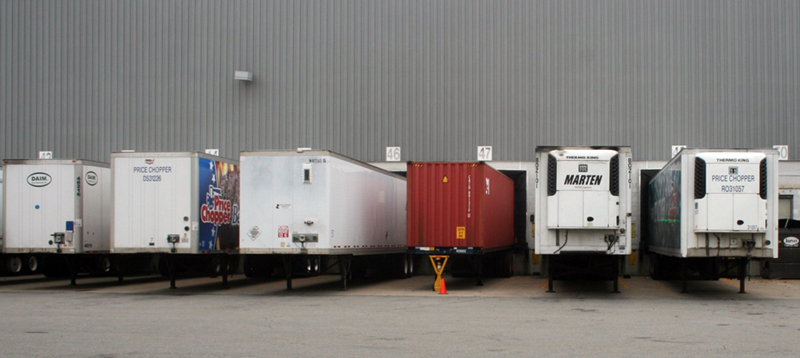
Source: Central Transportation Planning Staff.
Figure 5
Tractors: Terminal Tractor, Day Cab, and Sleeper

Source: Central Transportation Planning Staff.
Figure 6 shows a 53-foot semi-trailer on a flatcar. This type of piggyback service was introduced in the 1950s and, including intermodal containers, has grown consistently since. Flatcars that carry this size semi-trailer represent the longest railcars that are able to negotiate the tightest mainline turns in the North American rail system. This 53-foot length is now the nationwide standard maximum for semi-trailers and containers on both road and rail.
The next major intermodal innovation was double-stacking. This new technology depended on the development of well cars, also known as double-stack cars, as shown in Figure 7. These cars carry a container suspended between the train wheels rather than above the wheels as in a conventional flatcar, allowing a second container to be fastened directly above it and greatly increasing a train’s container carrying capacity. Double-stacking required new standards for railroad clearances, and not all lines can support this service.
Figure 7 also illustrates a third innovative breakthrough: domestic containers. Double-stacking was first introduced to handle ocean containers, which in their basic state have no wheels and get stacked on ships and wharves. Stacking them in new well cars was an obvious economy. A domestic container is 53 feet long and when attached to a chassis can be delivered exactly like a conventional semi-trailer (see Figure 5). Modern well cars can carry either 53-foot domestic containers or shorter, 40-foot ocean containers.
The container on the left in Figure 7 has a lifting hole in its upper rim. Directly below the lifting hole is the number 40 painted near the top edge of the well car. This indicates where an ocean container would be positioned if it were being carried. The lifting holes for a 53-foot domestic container are in the exact same position as the lifting holes in the corner posts of a 40-foot ocean container, allowing the same handling equipment at any terminal worldwide, seaport or rail, to handle any container.
Figure 6
Traditional Trailer-on-Flatcar

Source: Michael Barera.
Figure 7
Well Car (also known as Double-Stack Car)

Source: Central Transportation Planning Staff.
This section discusses 10 commercial intermodal warehouses in Massachusetts. These locations are illustrated with a set of nine figures. Figure 8 is a map of Massachusetts showing the locations of the 10 facilities and their relation to the limited-access highway system. The other eight figures are aerial photos showing the intermodal warehouses and nearby industrial facilities.
The 10 intermodal warehouses were identified using several online resources. The FAF4 online databases are companion resources to the FHWA’s Quick Response Manual. FAF4 has a Geographic Information System tool that allows the identification and retrieval of data about freight infrastructure, including intermodal terminals. The Massachusetts intermodal facilities included in the FAF4 database were checked individually online for current status and specific service offerings. Also, freight railroads in Massachusetts list their intermodal partners on their websites, and these were also reviewed. It is possible, however, that there may be other commercial intermodal warehouses with businesses similar to the sample presented here that were not identified.
The figures with the 10 intermodal warehouses are arranged roughly by increasing distance from Boston. There are two warehouses in the MPO region in the Wilmington-Woburn-Winchester industrial corridor. Then there are three figures showing facilities near the edge of the MPO region in Lawrence, Devens, and Mansfield. There are two figures for two distinct locations in Worcester, and in western Massachusetts there are intermodal warehouses in Palmer and Westfield, each with its own figure. The figure titles include the name of the town and the owner of the adjacent rail line.
The aerial photos have three colors of transparent shading representing three types of industrial land uses. The 10 featured intermodal warehouses and their associated truck parking and storage areas are highlighted in yellow. Other industrial operations shown that use an active freight rail siding are highlighted in mustard. Any freight-intensive industries that rely solely upon trucks are highlighted in salmon. Each figure has a legend that identifies each of the facilities with an active rail siding and other selected relevant locations.
The freight-intensive facilities highlighted here are not merely truck dependent in the same way as a large retail establishment. This analysis focuses on industrial operations whose business involves moving commercial quantities of materials or products into or out of a facility. The optimal location for these facilities might be in an expansive industrial area where the presence of heavy vehicles is the norm. In contrast, products leave large retailers in numerous light vehicles and the optimal location will be convenient for retail customers even if the store is supplied by large semi-trailers.

This study identified two commercial intermodal warehouses within the MPO region, and these two facilities, both owned by Tighe Warehousing and Distribution, are shown in Figure 9. The two Tighe warehouses are approximately two miles apart and are situated next to the Massachusetts Bay Transportation Authority (MBTA) commuter rail line to Lowell. To the north of the two warehouses are a cement distributor and a plywood distributor that also receive shipments by rail. Freight cars are brought to these four customers by Pan Am Railways, formerly the Boston and Maine Railroad. These are the only freight rail sidings on this line between Boston and North Billerica near I-495.
Much of the commercial and residential development visible in Figure 9 was part of the wave of post-World War II suburban development, facilitated to a large degree by newly constructed limited-access highways. New suburban industrial areas were heavily reliant on trucks, but carload freight rail service was once used by many more industrial customers here than the four shown.
This industrial corridor has evolved in response to real estate and transportation trends. Three trends specifically influence freight movements:
The Anderson-Woburn Regional Transportation Center has been a catalyst for this change, providing commuter rail, Amtrak, and Logan Express service, as well as ample long-term parking and convenient access to I-93. Hotels, big-box retail, laboratory, and residential structures are gradually being built on formerly industrial parcels.
This still remains a viable location for many industrial users, given the favorable zoning and freeway access. Indeed, Tighe Warehousing with its rail siding depends on the road network for both its intermodal truck and its truck-only movements. Interestingly, Tighe re-established carload rail service at its Winchester warehouse in 2013.
It is also noteworthy that the other two carload rail freight customers in Figure 9 are distributors of construction materials. Construction materials is one freight traffic market in which carload rail freight is still competitive.
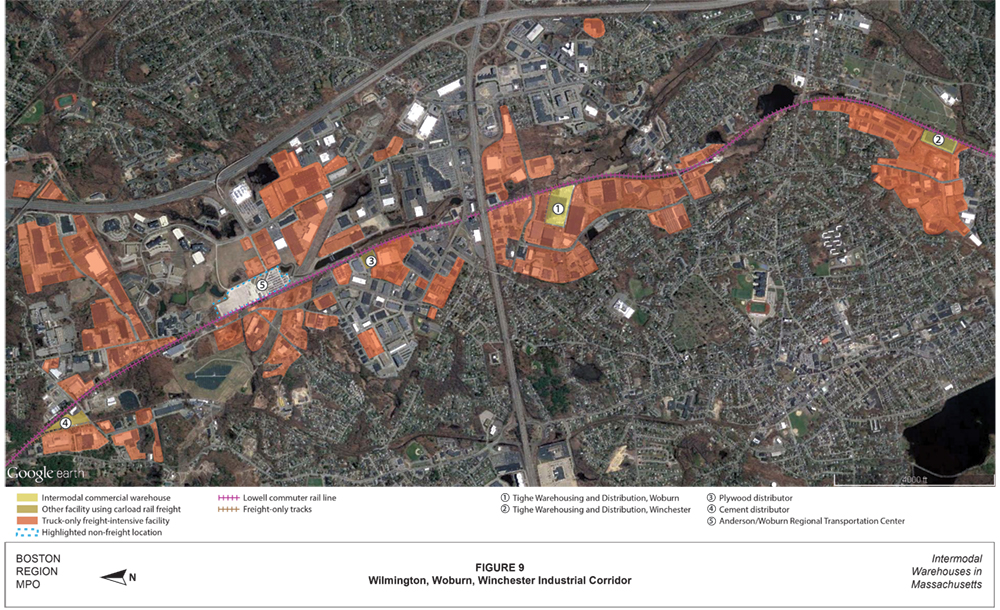
This study identified four commercial intermodal warehouses near the periphery of the MPO region. B&D Advanced Warehousing in downtown Lawrence is the northernmost of these and is shown in Figure 10. The B&D warehouse is situated next to the MBTA-owned commuter rail line to Haverhill. This section of track is also on the Pan Am Railways mainline, over which freight trains operate between upstate New York and upper New England and the Canadian Maritime provinces. Pan Am Railways also delivers freight cars to the B&D warehouse.
Industry settled in this part of Lawrence in the 1800s because of the availability of water power. A dam on the Merrimack River is clearly visible on the left in Figure 10, and canals on both the north and south sides of the river brought water from upriver of the dam to mills downriver from the dam, allowing the mills to use economical water turbines as an alternative to steam or electric power. Mills using water power were multi-level structures that became obsolete in the 1950s as virtually all heavy manufacturing shifted to single-level structures.
Almost all freight-intensive activity has departed this part of Lawrence for more geographically extensive industrial areas. The historic mill that New Balance had once used as a warehouse it now uses for offices and outlet store. New Balance’s modern facility is still in Lawrence, however.
One reason that the B&D warehouse can be successful at this location is its convenient access to I-495, visible on the right in Figure 10. The warehouse is FDA-approved and the rail siding was brought indoors when the warehouse was expanded.
Most of the former industrial buildings have been repurposed for nonindustrial uses, but large-scale new development has been notably lacking. A recently constructed commuter rail station with attached parking garage is across the street from the B&D warehouse, and this might someday be a catalyst for development. Unless property values appreciate significantly, however, B&D Warehousing may continue to be one of the last remaining industrial operations in the historic mill district of Lawrence.
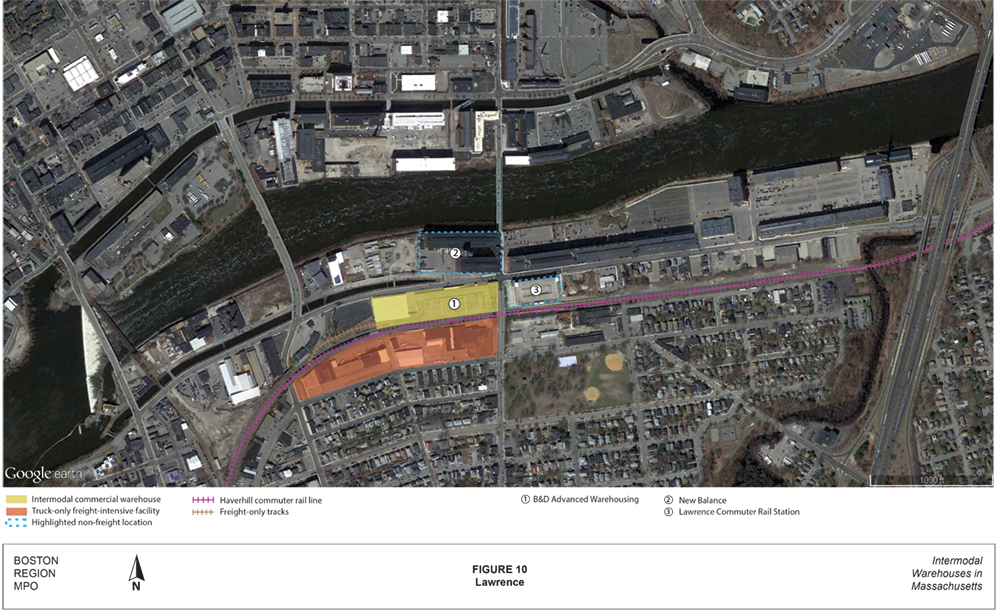
The towns of Ayer and Harvard are immediately west of Littleton at the northwest edge of the MPO region. After its deactivation, parts of Fort Devens in Ayer, Harvard, and Shirley were conveyed to the state agency MassDevelopment. Now known as Devens and still owned by MassDevelopment, this area is being transformed into a mixed-use community with a focus on sustainable economic development. Devens has convenient rail access, and companies using carload freight rail service have been encouraged to establish operations there. The section of Devens with rail access is shown in Figure 11.
Devens is near the eastern end of the Pan Am Southern Railway. Pan Am Southern is jointly owned by the Norfolk Southern Railway and the Pan Am Railway. Pan Am Southern connects in upstate New York with the extensive Class I railroad systems of Norfolk Southern, CSX, and Canadian Pacific. The Pan Am Railway mainline extends northeast from Devens to New Hampshire, Maine, and New Brunswick in Canada. The MBTA owns most tracks where it operates commuter rail service, but Pan Am Southern has exclusive trackage rights to operate freight service at this location
Pan Am Southern operates an intermodal terminal at this location, transferring 40-foot ocean containers, 53-foot domestic containers, and conventional rubber-tired semi-trailers onto and off of intermodal trains that serve locations across the continent, including west coast ports. These containers and semi-trailers are hauled into and out of this terminal by truck tractors, and their ultimate origin or destination might be anywhere in New England. This business of simply transferring trailers and containers between the highway and rail modes is not the subject of this study.
NEPW Logistics is Pan Am Southern’s intermodal partner. NEPW operates in a recently expanded intermodal warehouse, described above, which is a short distance from the intermodal lift operation. Customers who store goods in the warehouse can easily arrange for NEPW to expedite a container shipment to anyplace in North America. NEPW shares the warehouse with other firms, some of which use boxcars.
Most of the industrial parcels at Devens have been developed. Some use both trucks and carload rail freight, and some operations use only trucks. MassDevelopment has a master plan and the extent and nature of the industrial, residential, research, and community parts of Devens are unlikely to change significantly in the way that has happened in the Wilmington-Woburn-Winchester corridor.
Long-distance intermodal rail freight has enjoyed a long-term growth trend. The Pan Am Southern lift operations at this location will probably participate in this positive trend into the foreseeable future, and there are opportunities to further expand and modernize this terminal. The nearby NEPW Logistics intermodal warehouse should be able to grow as well within its logistic service market niche.

Mansfield has two major industrial areas with modern, single-level facilities, some with active rail sidings. The larger area is near the interchange of Interstates 95 and 495. The smaller location, shown in Figure 12, is located roughly two miles from the interstate highways and is bordered by housing and undeveloped land. Two commercial intermodal warehouses operate at this smaller location.
The industrial rail spur that serves this area connects with the MBTA’s Providence line, which is part of the Northeast Corridor and is also used for Amtrak’s high-speed Acela service. Freight car deliveries by rail carrier CSX must operate for a short distance on the passenger line, shuttling cars to and from a freight-only branch line that connects with the Northeast Corridor near the Mansfield commuter rail station. The other industrial area is served in the same manner.
When overhead power distribution catenary was installed on this line to allow use of electric locomotives, a height of the catenary was specified that would allow freight rail operations with the types of large rail equipment now commonly used. The presence of rail freight customers on important passenger rail lines is a feature of North American railroads that complicates the introduction of high-speed rail services.
The two intermodal warehouses highlighted in Figure 12 are owned by logistic firms that operate at multiple locations. The Tighe warehouse is part of a system that includes the facilities in Woburn and Winchester.
Advanced Warehouses is an affiliate of Intransit Containers, which operates a lift-only intermodal terminal in Worcester. The Worcester facility is small, and containers can be driven to its Mansfield facility where warehouse space is available and containers and chassis can be stored in the adjacent paved and secured lot. Intransit emphasizes its foreign trade-related logistic services, and has obtained U.S. Customs bonded warehouse and free-trade zone status at its Mansfield operations.

Two commercial intermodal warehouses were identified in Worcester. One has a rail siding off of the MBTA Worcester commuter rail line and the other is served by the Providence and Worcester railroad. Regency Transportation operates the warehouse served from the MBTA Worcester line, and this facility is shown in Figure 13.
Regency owns five warehouse facilities, four of which are in Massachusetts and one is in New Jersey. The warehouse in Worcester, located in a residential neighborhood, is the only one with a rail siding. The other three Massachusetts facilities are in well-defined industrial areas.
Regency has its own truck fleet and drivers and specializes in same-day and just-in-time deliveries. It handles primarily food, consumer products, and general merchandise. In 2018 it acquired a trucking company with a warehouse and truck fleet based in Chicopee.
Evaluating the business plans of the individual logistics companies is beyond the scope of this study, but the recent acquisition in Chicopee suggests that Regency is growing and shaping its business. An intermodal warehouse situated like this may be unusual, but it may be a viable business location as long as the facilities remain competitive for the products handled. The one clear drawback of this location is that expansion at this location would be impossible and increasing Regency’s intermodal capabilities could require setting up an intermodal warehouse at a different location.

The MBTA Worcester commuter rail service extends four miles beyond the Regency warehouse to Worcester Union Station. CSX operates an extensive intermodal lift operation near Union Station that serves as the eastern endpoint for CSX intermodal rail services. The CSX mainline west of Worcester accommodates double-stacked containers.
The CSX mainline meets the Providence and Worcester Railroad (P&W) just west of Union Station. The P&W is a regional short line railroad, and it has several carload rail customers and intermodal partners in Worcester. Three miles beyond Union Station along the P&W is a tightly spaced cluster of rail customers, including Mid-States Packaging and Distributing (see Figure 14). The straight-line distance between the Regency and Mid-States warehouses is only two and one-half miles.
The intermodal warehouse used by Mid-States was completed in 2017. Mid-States had operated in a former U.S. Steel facility that had been largely vacant since the 1970s. The new warehouse was built by Imperial Distributors, which distributes non-grocery items to regional retailers. Imperial uses about half of the warehouse, and Mid-States uses the remaining space to provide logistic services. Both businesses use rail boxcars.
Also visible in Figure 14 is the Intransit Container lift facility. Most of the containers in Figure 14 are 40-foot ocean containers used in foreign trade, the logistic specialty of Intransit. There is little room at this location for storage, and containers not driven from this facility directly to the final customer may be trucked to Intransit’s affiliate, Advanced Warehouses in Mansfield (Figure 12). Some 20-foot containers are also visible, another standard container size used in ocean shipping
Also visible in Figure 14 are the extensive transload facilities operated by A&R Logistics. The term “transload” often refers to bulk commodities such as cement. It takes up to three of the largest dry bulk semi-trailers to transport the contents of one large rail hopper car. The actual transloading operation can take place anywhere along the paved apron next to the tracks where the hoppers have been placed.
Rail-based businesses usually benefit from economies of scale, and this location does not appear to offer much opportunity for expansion by these businesses. However, all these businesses have modernized their facilities since Route 146 was upgraded to a limited access highway in 2002.

New England Central Railroad is a regional short line railroad with tracks in Vermont, Massachusetts, and Connecticut. It is owned by Genesee & Wyoming, Inc., which owns a worldwide portfolio of regional railroads and related transportation properties. The P&W, discussed above, is a recently acquired Genesee & Wyoming property.
Maple Leaf Distribution Services is one of New England Central’s intermodal partners and is located in Palmer about 29 miles west of Worcester and 14 miles east of Springfield. Maple Leaf is located in the Palmer Industrial Park, shown in Figure 15. The Maple Leaf warehouse has 60 truck loading bays and can accommodate up to 32 rail cars at once.
Maple Leaf specializes in handling forest products and metal or other commodities including canned foods. These basic goods, however, are transported primarily in boxcars and dry vans, and stored as required in a warehouse. Handling of bulk commodities and outdoor storage are not part of its business offerings.
Another New England Central intermodal partner, Prime Distribution is also located in this well-defined industrial park. Prime stores and distributes building materials from an extensive outdoor area. Three smaller operations receive carload freight including tank cars. About half the facilities in Palmer Industrial Park use trucks only.
Palmer Industrial Park is mostly surrounded by undeveloped land, but is near some residential neighborhoods. All nearby housing is separated from the industrial area by green buffers. Maple Leaf was founded in 1985 and expanded its warehouse in 2005. Further expansion at this location would probably require taking over an adjacent industrial facility.
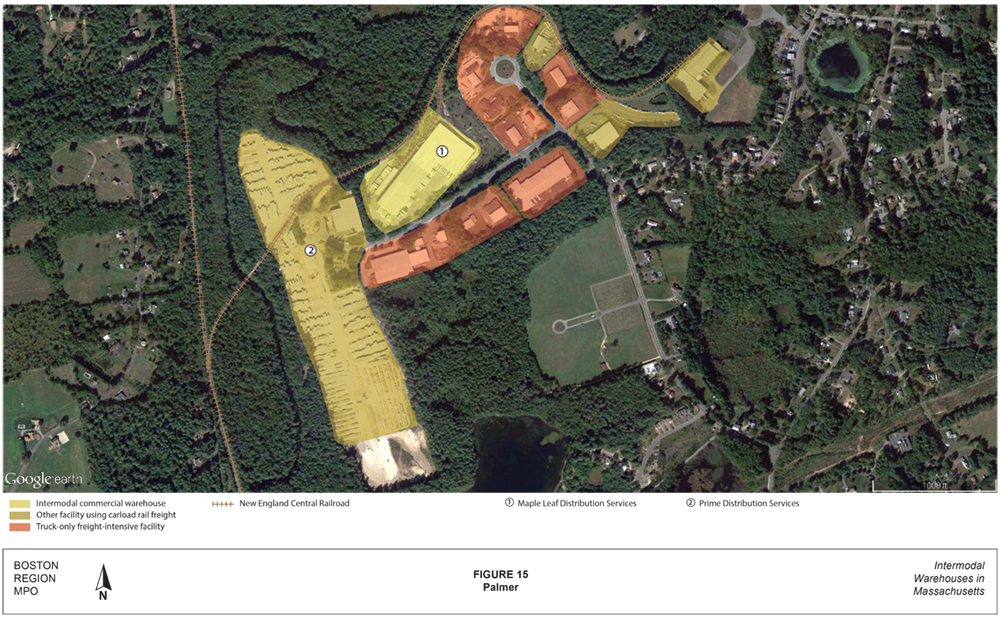
Pioneer Valley Railroad is a short line railroad that connects with the CSX mainline in Westfield, eight miles west of downtown Springfield, and serves a number of industrial customers in Westfield and Holyoke. Westfield offers logistic operations two important benefits: abundant land and convenient access to the express highway system. On the right side of Figure 16 at the south-most part of the aerial photo is Interstate 90 and Interchange 3 in Westfield. Interstate 90 meets Interstate 91 a few miles to the east at Interchange 4, offering convenient access for motor carriers to New York City, Connecticut, upper New England, and Canada. Interstate 90, of course, connects Westfield with Boston and upstate New York.
Even in this important nexus of the interstate highway system, the availability of carload rail freight service provides an additional transportation capability for companies to use. A. Duie Pyle Warehouse & Distribution is an expanding transportation and logistics company serving the Middle Atlantic, New England, and eastern Canada. It now has three warehouses in Westfield, each of which is labeled in Figure 16, and each has a rail siding from Pioneer Valley Railroad. A. Duie Pyle also uses some of the space in the expanded warehouse in Devens.
The nationwide home improvement store chains, Lowe’s and Home Depot, have constructed major distribution operations in Westfield. The Lowe’s operation distributes building materials to regional stores that need to be transported on flatbed trucks. This distribution center has two rail siding tracks, with one adjacent the warehouse where cars can be unloaded using conventional warehouse forklifts. A second track is in the paved lot in front of the warehouse and requires larger, specialized unloading equipment.
The largest warehouse visible in Figure 16 is a Home Depot regional distribution center. The warehouse is more than one-quarter mile in length and is lined by more than 250 loading bays along three of its four sides. This facility has no rail siding, and with only a handful of exceptions, all the semi-trailers visible appear to be conventional 53-foot dry vans. Home Depot at this location has a system based on a uniform vehicle fleet implemented on a massive scale. This is in contrast with A. Duie Pyle whose customers use a mix of modes and vehicle types and contract for a much smaller scale of logistic services.
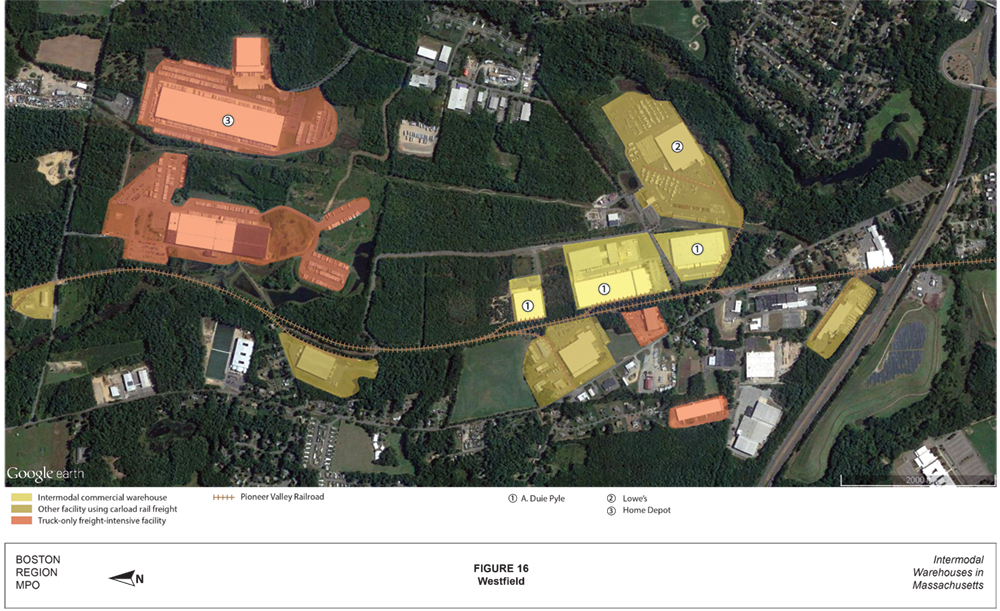
Intermodal commercial warehouses provide a number of logistic services. These services can be considered in four groups:
The 10 commercial warehouses highlighted in the study offer services in some or all of these areas, and all 10 use carload rail freight. Rail carload freight, especially hi-cube boxcars, is a large-capacity complement to the ubiquitous tractor and semi-trailer combination.
Every business that involves the ownership and movement of goods must address these four functions to some extent. Most companies perform some of the logistic tasks themselves with some larger firms developing a complete array of in-house logistic capabilities. Firms with extensive logistic operations may, however, use commercial warehouses for certain product lines or regions. For smaller firms, the economies of contracting logistic services of a commercial warehouse may be compelling.
It is impossible to generalize about the 10 commercial warehouses described in this study. The facilities range from old to newly opened and from moderately sized to gargantuan. The locations range from an old mill district to postwar suburbs to distant greenfield sites. Some are ensconced within a well-defined industrial area and others are adjacent to residential housing. Some provide their services from a facility that they control exclusively and others operate from space used within a larger shared warehouse.
Implicit in the above observations is that these commercial warehouses are selling services. The key requirement of their physical plant is that it supports the services provided to their current and prospective customers.
This study describes the locales of 10 commercial intermodal warehouses in the region, focusing on industrial and nonindustrial land uses. These locations represent only a small portion of the industrial capacity of Massachusetts and the MPO region, and were selected for study solely because of the business plans of the 10 warehouses.
Subsequent analysis can build on this work, however. The freight components of the travel demand models used by the MPO are being steadily improved, and techniques are being explored to incorporate site-specific operational information into the trip generation and trip distribution model steps. This process begins, however, by learning what is actually taking place at industrial sites throughout the region.
Similar studies might be undertaken by identifying another specific type of industrial activity with a manageable number of identifiable locations. The distribution warehouses of supermarket chains are one example, as well as bulk commodity transfer terminals. Ideally, quantitative information could be obtained to supplement the geographical analysis. Interviews, vehicles counts, and gate surveys can provide valuable information, but require cooperation from the facilities’ management.
Finally, local area freight studies, or in this case, single-page descriptions, can provide useful background for more general planning efforts. Industrial activity is scattered throughout the region and is present in a large variety of neighborhoods and urban forms. Ideally, industrial needs and issues will be considered at the outset of planning studies.
1 Massachusetts Department of Transportation, Massachusetts Freight Plan: Technical Memorandum #1 (Prepared by Cambridge Systematics, Inc., December 2016), Page 11.
2 Trucks in the South Boston Waterfront, Boston Region MPO, April 2017.
3 Federal Highway Administration, Quick Response Freight Manual II, (Prepared by Cambridge Systematics, Inc., September 2007)